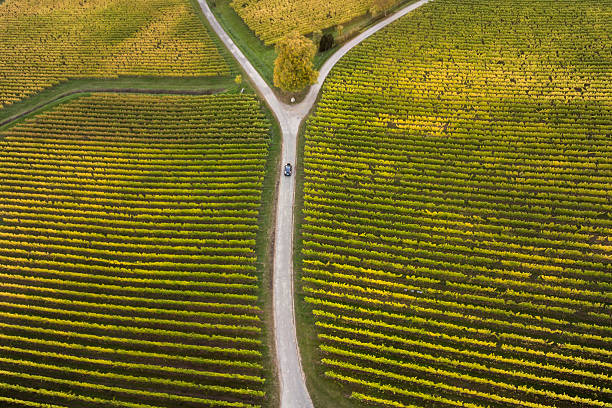A while ago, some wags thought they would do wine drinkers a service by coming up with the acronym, "ABC." Suggesting an "Anything But Chardonnay" drinking strategy was not only presumptuous, it was silly.
I say presumptuous, because there are a helluva lot of people that enjoy a glass of Chardonnay. And, "ABC" is a silly ban since Chardonnay is planted in all the major wine regions. Like it or not, Chardonnay is synonymous with white wine.
But the ABC miss-adventure also got me thinking: Imagine trying to float the idea of "Anything But Riesling," in Germany. Not likely, since 23% of Germany's 135 varieties are Riesling. And, 67% of that 135 are white grapes, which means, that while Riesling still holds a firm place, there is a lot more to German white wine.
Tongue-twisting grape names like Scheurebe, Roter Traminer, Grauburgunder (Pinot Gris), Müller-Thurgau and Gewurztraminer, are fairly common in Germany, but they don't have the caché of Riesling. Lesser known are Trollinger and Weissburgunder (Pinot Blanc).
Roter Traminer is also known as Savagnin Rose, a non aromatic version of Gewürztraminer. Savagnin, an ancient variety, is connected through genetic to many modern grapes, including Chenin Blanc and Sauvignon Blanc. And, Ruländer, the traditional German name for Pinot Gris, appears on wine labels, along with Grauburgunder.
 |
| Pfalz vineyard |
Germany's Pfalz region is home to a number of these lesser known white grapes. Pfalz sits atop the point where the Saar and Rhine rivers meet. To the north is Nahe and Rheinhessen, with Baden in the southeast. Many of these grapes are grown in Baden, Nahe and north along the Mosel.
A Closer Look
Scheurebe is a recent arrival on the vineyard scene, first in the Rheinhessen, then the Pfalz. Developed as a cross of Riesling and Bukettraube, itself an obscure cross. The aim was to grow Scheu, its common name, as a replacement for the noble Riesling. There were problems with getting Scheu to the desired ripeness, because slightly green, it made a harsh wine. Scheurebe has good acidity, supporting black currant flavors and an edgy citrus note.
Pinot Gris is an adaptable grape that does quite well in Alsace, northern Italy as Pinot Grigio and Oregon, where its honeyed flavors are a good foil for Chardonnay. German Pinot Gris is popularly known as Ruländer and Grauburgunder. The best examples offer ripe pear and nutty flavors with a subtle trace of wild honey.
Pinot Blanc, called Weissburgunder in Germany, is a mutation of Pinot Gris, tracing its heritage to Burgundy's Pinot Noir. An attractive feature of Pinot Blanc is its creamy texture. That, plus good acidity and flavors that resemble ripe apples, put Pinot Blanc in the Chardonnay taste-alike category.
Müller-Thurgau was, for German wine, the great white hope. While working in Switzerland, Dr. Müller developed a cross of Riesling and Silvaner, naming the new grape for the canton of Thurgau in Switzerland. Müller's idea was to combine the quality of Riesling with the reliability of Silvaner. Despite a general lack of enthusiasm for the grape, M-T was widely planted, producing oceans of uninspiring Liebfraumilch, Piesporter and others of the same ilk. Today, when it is remembered, Müller-Thurgau, with its hint of Muscat, is mostly the backbone of what the Brits call "cheap and cheerful" wine.
| Gewürztraminer |
Gewürztraminer, an aromatic variant of Savagnin, has one of the most recognizable grape and wine aromas: exotic spices, lychee and perfumed roses. Occasionally, GT is sometimes shown as Gewürz-Traminer, the perfumed variant of the Traminer grape. The German word "gewürz," when applied to the grape, means perfumed more than spice. GT is grown throughout Germany and Europe. In 1973, the official grape name was altered, dropping the umlaut, in the French region of Alsace, across the Rhine river from Germany.
Trollinger likely came to Germany from northern Italy. Historically, Trollinger and Roter Traminer trace a history in Wurttemberg, back to the 14th century. Locals in this small region east of Baden, enjoy the light red wine produced from the red-skin grape.
Riesling is a noble variety that displays its greatness as a dry, sweet or sparkling wine. But Riesling can be problematic to grow, so vintners turned to other white varieties, including crosses, to counter problems in the vineyard and the marketplace. Although efforts have been mixed, the result is a collection of wines, worth a try.
Next post: The 3Ms of Dessert Wines
Leave a comment at boydvino707@gmail.com



No comments:
Post a Comment
Note: Only a member of this blog may post a comment.